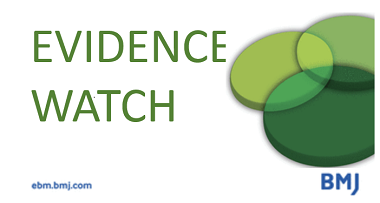A systematic review concludes that frailty is a predictor of mortality, but does it aid decision making in practice?
Carl Heneghan
 A recent systematic review included 18 cohort studies including 65,048 participants. The results suggested that higher Frailty index was significantly associated with higher mortality risk. For every 0.01 increase in the index the risk rose by 4% (= 1.04, 95% CI = 1.03 to 1.04) and by about 28% per 0.1 increase in the index (1.28, 95% CI = 1.26-1.31). Studies with shorter follow-up periods and lower numbers of female were associated with higher mortality risks by Frailty Index.
A recent systematic review included 18 cohort studies including 65,048 participants. The results suggested that higher Frailty index was significantly associated with higher mortality risk. For every 0.01 increase in the index the risk rose by 4% (= 1.04, 95% CI = 1.03 to 1.04) and by about 28% per 0.1 increase in the index (1.28, 95% CI = 1.26-1.31). Studies with shorter follow-up periods and lower numbers of female were associated with higher mortality risks by Frailty Index.
How does this help?
Previous systematic reviews have shown that frailty is prevalent a strong predictor of mortality and that older frail men have a higher risk of mortality than women. So nothing new there.
The Frailty index is calculated by measuring 40 healthcare variables that include signs, symptoms, laboratory abnormalities, cognitive impairments, and disabilities in activities of daily living. The frailty index is equal to the (number of health deficits present) ÷ (number of health deficits measured). So a person with 10 deficits out of 40 measured has a frailty index of 0.25.
The list of variables is in table 1 (see here for the paper). The number of variables means this is a difficult measure to use in practice, many of these are highly variable and most predict not only frailty but also worsening functionality and disease. One issue in the table – that does surprise me – is that a BMI of >30 is considered a deficit and therefore adds to a frailty score.
As opposed to complex scales what we need in practice is simple tools to predict risk. It’s fairly obvious that if you score high on the frailty index you are unwell – do you actually require the score to know that. In out of hours I use simple rules of thumb, such as can you get to the toilet? If the answer is no, my experience tells me, we have a problem.
The important message is not all evidence helps with decision making; in this case, this is an interesting paper that reminds me of the importance of frailty, but the Index itself won’t help me in practice. And if you know the predictive value of the toilet test, I’d be interested to know.
References
Development and validation of an electronic frailty index using routine primary care electronic health record data. Clegg A, et al. Age Ageing. 2016 May;45(3):353-60. doi: 10.1093/ageing/afw039. Epub 2016 Mar 3. Erratum in: Age Ageing. 2017 Jan 17;:.
Frailty index as a predictor of mortality: A systematic review and meta-analysis. Age and Ageing, 47(2), 193–200.Kojima G. et al. (2018).

BMJ Evidence-Based Medicine – original evidence-based research, insights and opinions on what matters for health care.
Carl Heneghan is Professor of EBM at the University of Oxford, Director of CEBM and Editor in Chief of BMJ Evidence-Based Medicine
Follow on twitter @carlheneghan
Table 1> Development and validation of an electronic frailty index using routine primary care electronic health record data. Age Ageing. 2016 May;45(3):353-60.
| List of 40 Variables included in the frailty index | Cut Point |
| Help Bathing | Yes = 1, No = 0 |
| Help Dressing | Yes = 1, No = 0 |
| Help getting in/out of Chair | Yes = 1, No = 0 |
| Help Walking around house | Yes = 1, No = 0 |
| Help Eating | Yes = 1, No = 0 |
| Help Grooming | Yes = 1, No = 0 |
| Help Using Toilet | Yes = 1, No = 0 |
| Help up/down Stairs | Yes = 1, No = 0 |
| Help lifting 10 lbs | Yes = 1, No = 0 |
| Help Shopping | Yes = 1, No = 0 |
| Help with Housework | Yes = 1, No = 0 |
| Help with meal Preparations | Yes = 1, No = 0 |
| Help taking Medication | Yes = 1, No = 0 |
| Help with Finances | Yes = 1, No = 0 |
| Lost more than 10 lbs in last year | Yes = 1, No = 0 |
| Self Rating of Health | Poor = 1, Fair = 0.75, Good = 0.5, V. Good = 0.25, Excellent = 0 |
| How Health has changed in last year | Worse = 1, Better/Same = 0 |
| Stayed in Bed at least half the day due to health in last month | Yes = 1, No = 0 |
| Cut down on Usual Activity (in last month) | Yes = 1, No = 0 |
| Walk outside | <3 days = 1, ≤ 3 days = 0 |
| Feel Everything is an Effort | Most of time = 1, Some time = 0.5, Rarely = 0 |
| Feel Depressed | Most of time = 1, Some time = 0.5, Rarely = 0 |
| Feel Happy | Most of time = 0, Some time = 0.5, Rarely = 1 |
| Feel Lonely | Most of time = 1, Some time = 0.5, Rarely = 0 |
| Have Trouble getting going | Most of time = 1, Some time = 0.5, Rarely = 0 |
| High blood pressure | Yes = 1, Suspect = 0.5, No = 0 |
| Heart attack | Yes = 1, Suspect = 0.5, No = 0 |
| CHF | Yes = 1, Suspect = 0.5, No = 0 |
| Stroke | Yes = 1, Suspect = 0.5, No = 0 |
| Cancer | Yes = 1, Suspect = 0.5, No = 0 |
| Diabetes | Yes = 1, Suspect = 0.5, No = 0 |
| Arthritis | Yes = 1, Suspect = 0.5, No = 0 |
| Chronic Lung Disease | Yes = 1, Suspect = 0.5, No = 0 |
| MMSE | <10 = 1, 11–17 = 0.75, 18–20 = 0.5, 20–24 = 0.25, >24 = 0 |
| Peak Flow | ≤ 340 for men, ≤ 310 for women |
| Shoulder Strength | ≤ 12 for men and ≤ 9 for women |
| BMI | <18.5, ≥ 30 in men and <18.5, ≥ 30 as a deficit |
| Grip Strength | |
| Usual Pace Walk (sec) | >10 |
| Rapid Pace Walk (sec) | >16 |
Competing interests
Carl has received expenses and fees for his media work including BBC Inside Health. He holds grant funding from the NIHR, the NIHR School of Primary Care Research, The NIHR Oxford BRC and the WHO. He has also received income from the publication of a series of toolkit books. CEBM jointly runs the EvidenceLive Conference with the BMJ and the Overdiagnosis Conference with some international partners which are based on a non-profit model.